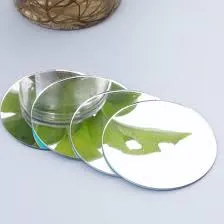

The Allure of One-Side Mirror Glass A Glimpse into Transparency and Privacy
In our modern world, where technology and design intersect, one particular material has captured the imagination of architects, designers, and business innovators alike one-side mirror glass. This fascinating material, often referred to as two-way or one-way mirror glass, serves both functional and aesthetic purposes, creating a unique balance between transparency and privacy.
Understanding One-Side Mirror Glass
One-side mirror glass is a type of reflective glass that allows light to pass through in one direction while reflecting light in the opposite direction. This unique property makes it possible for those on one side of the glass to see through it, while those on the other side see only their reflection. This one-way vision is achieved by applying a thin metallic coating to the glass surface, which enhances its reflective qualities while still allowing for a degree of transparency.
The practical applications of one-side mirror glass are diverse, spanning uses in security, architecture, and interior design. In security settings, for instance, this glass allows for surveillance while maintaining the illusion of a solid wall. Observers in a control room can monitor activities in a public space without being detected, ensuring both safety and discretion.
The Architectural Vision
Architects and designers have embraced one-side mirror glass for its aesthetic qualities, which contribute to the overall design of buildings and spaces. When integrated into facades, this glass can create stunning visual effects, reflecting the surrounding environment and allowing structures to blend seamlessly into their settings. This reflective quality can be particularly advantageous in urban environments, where space is limited, and maximizing natural light is crucial. One-side mirror glass creates an illusion of openness, making interiors feel more expansive while ensuring privacy for occupants.
Moreover, this glass is not only practical but also environmentally friendly. By reflecting sunlight, one-side mirror glass can reduce heat gain in buildings, leading to lower energy consumption for cooling. This characteristic aligns with growing trends toward sustainable design, where energy efficiency and environmental responsibility are paramount.

Interior Applications
On an interior level, one-side mirror glass is increasingly popular in residential and commercial settings alike. It is often used in office spaces to create conference rooms that offer both privacy and transparency. Employees can work effectively without the distraction of outsiders while still maintaining a connection to the broader workspace. This design choice fosters an environment of openness and collaboration, essential in today’s dynamic workplaces.
In homes, one-side mirror glass adds a touch of elegance and sophistication. It can be used in bathrooms, bedrooms, or living areas to create reflective walls that enhance the sense of space and light. When strategically placed, it can even serve as a piece of art, transforming ordinary rooms into stunning showcases of modern design.
Privacy and Ethical Considerations
While the benefits of one-side mirror glass are numerous, it also raises important ethical considerations regarding privacy. In public spaces such as shopping malls, airports, or even law enforcement settings, the use of this glass can lead to a sense of surveillance. As individuals go about their daily lives, they might be unaware that they are being observed. This potential for intrusion prompts a crucial conversation about the balance between security and privacy in public environments.
Consequently, designers and architects must navigate these ethical dilemmas with care, ensuring that the use of one-side mirror glass aligns with principles of transparency and consent. Clear signage and communication can help mitigate feelings of unease, allowing individuals to make informed choices about their presence in these mirrored spaces.
Conclusion
In conclusion, one-side mirror glass is a remarkable material that embodies the delicate interplay between transparency and privacy. Its diverse applications in architecture, interior design, and security showcase its versatility and aesthetic appeal. However, as we continue to embrace this innovative glass, it is essential to remain vigilant about the ethical implications it presents. By fostering a design approach that values user awareness and consent, we can fully leverage the advantages of one-side mirror glass while respecting the privacy and comfort of individuals in both public and private spaces. As we look to the future, it is clear that one-side mirror glass will continue to play a significant role in shaping our environments, reflective of both our technological advancements and our evolving societal values.